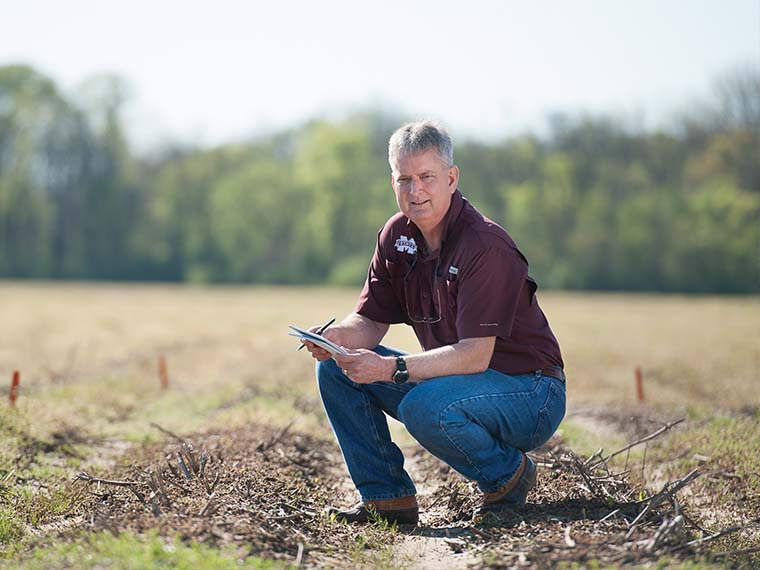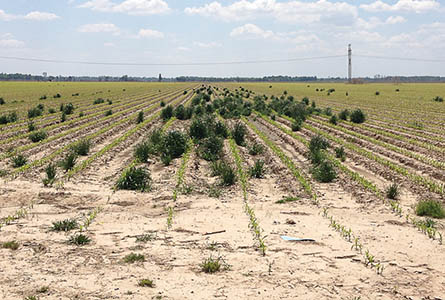The information presented on this page may be dated. It may refer to situations which have changed or people who are no longer affiliated with the university. It is archived as part of Mississippi State University's history.
As Jason Bond, MAFES associate research professor at MSU's Delta Research and Extension Center, conducts research and develops prescriptions to help farmers control weeds, MAFES researcher Dan Reynolds has several herbicide-related projects focused on improving production and reducing costs for farmers.
Bond is focused on controlling weeds that are resistant to specific herbicides. Currently, he is experimenting with glyphosate-resistant Italian ryegrass. This prolific weed, resistant to the herbicide commonly known as Roundup, was discovered in row crops for the first time in Mississippi.
"I've personally seen this weed in 70 of the 82 counties in Mississippi," Bond said. "It's also a problem for neighboring states like Arkansas, Louisiana, and Tennessee. The region looks to Mississippi to help establish best practices for managing this weed."
Bond along with other MSU researchers developed a comprehensive herbicide program to manage the resistant Italian ryegrass.
While the program requires at least two applications, Bond says the combination of a fall application between mid-October and mid-November, a winter application in January, and a spring application in March produces optimum results.
"We recommend residual treatments in the fall and postemergence herbicide treatments before spring planting. This approach has proven effective at controlling glyphosate-resistant Italian ryegrass," Bond said. "Our goal is to go from concept to a grower's field in 18-24 months if it's a good concept applicable to Mississippi growers. We've had success with this program and farmers are adopting it throughout the Mid-south."
Broad-scale adoption of herbicide-tolerant cropping systems over the past two decades has led to the evolution of herbicide-resistant weeds. Controlling these weeds requires use of multiple herbicides with different modes of action. Emerging technologies will include crops with tolerance to multiple herbicides. Herbicide-resistant traits in crops make weed control more effective, however, herbicide drift can reduce yield on neighboring crops not immune to the prescribed herbicide.
The first step in diagnosing drift is evaluating the symptoms. Reynolds and his team evaluate auxin technologies like dicamba and 2,4-D.
In a recent research project, the team analyzed the effects of dicamba and 2,4-D on soybean growth and yield, applying varying concentrations at the vegetative and reproductive growth states. Researchers assessed visual injury and plant height at 14 and 28 days after treatment. They also examined yield loss.
Plants exposed to 2,4-D had visual injury that reduced over time, plant heights were not indicative of the injury, and the highest concentration resulted in a 46 percent yield loss. The yield loss differences between the last three fractional rates were not discernible.
The dicamba-treated plants had significant and consistent visual injury at both growth states. Increased injury resulted in shorter plants. Yield loss was greater in the higher dicamba rates and impacted the plants in the reproductive stage the most. The highest concentration of dicamba resulted in a 98 percent yield loss while the lowest rate still significantly reduced yield by 16 to 29 percent compared to the untreated plants.
"Overall, visual injury, plant stunting, and yield losses were greater with dicamba versus the 2,4-D," Reynolds said. "The highest concentration of dicamba resulted in a 98 percent yield loss compared to 46 percent yield loss in the 2,4-D-treated plant."
The team plans to replicate the study in hopes of determining how detrimental herbicide drift injury is for soybeans not tolerant to these herbicides. Reynolds took the research a step further and in another research project examined large-scale herbicide drift with fixed-wing aircraft, UAV technology, and ground-based spectral reflectance. His team evaluated the effect of drift reduction technology on soybeans injured with a herbicide containing dicamba. They assessed data collection methods for mapping drift injury on large landscapes to develop a pictorial guide for rating dicamba injury. "We hope this research helps provide an objective tool for recognizing and assessing drift injury from auxin herbicides at the field and landscape levels," Reynolds said. MSU's scientists researching weed control and herbicide drift help contribute to improved technologies and the development of best practices that help farmers reduce cost and increase productivity.

